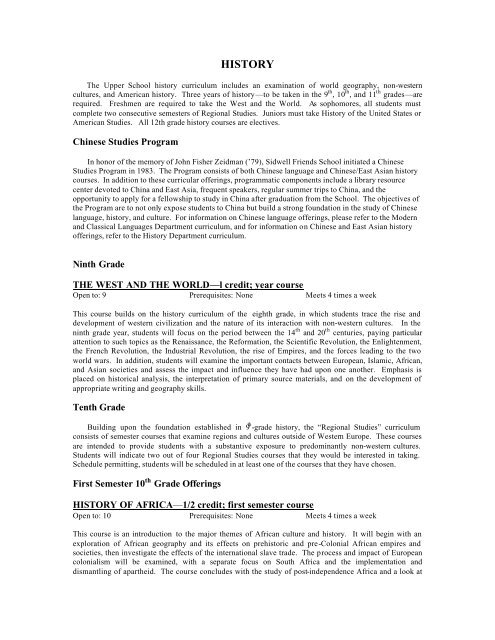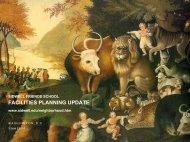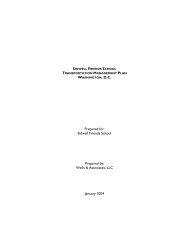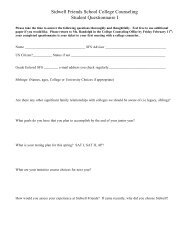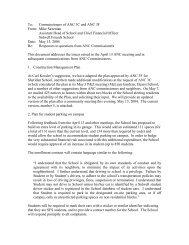HISTORY - Sidwell Friends School
HISTORY - Sidwell Friends School
HISTORY - Sidwell Friends School
You also want an ePaper? Increase the reach of your titles
YUMPU automatically turns print PDFs into web optimized ePapers that Google loves.
<strong>HISTORY</strong><br />
The Upper <strong>School</strong> history curriculum includes an examination of world geography, non-western<br />
cultures, and American history. Three years of history—to be taken in the 9 th , 10 th , and 11 th grades—are<br />
required. Freshmen are required to take the West and the World. As sophomores, all students must<br />
complete two consecutive semesters of Regional Studies. Juniors must take History of the United States or<br />
American Studies. All 12th grade history courses are electives.<br />
Chinese Studies Program<br />
In honor of the memory of John Fisher Zeidman (’79), <strong>Sidwell</strong> <strong>Friends</strong> <strong>School</strong> initiated a Chinese<br />
Studies Program in 1983. The Program consists of both Chinese language and Chinese/East Asian history<br />
courses. In addition to these curricular offerings, programmatic components include a library resource<br />
center devoted to China and East Asia, frequent speakers, regular summer trips to China, and the<br />
opportunity to apply for a fellowship to study in China after graduation from the <strong>School</strong>. The objectives of<br />
the Program are to not only expose students to China but build a strong foundation in the study of Chinese<br />
language, history, and culture. For information on Chinese language offerings, please refer to the Modern<br />
and Classical Languages Department curriculum, and for information on Chinese and East Asian history<br />
offerings, refer to the History Department curriculum.<br />
Ninth Grade<br />
THE WEST AND THE WORLD—l credit; year course<br />
Open to: 9 Prerequisites: None Meets 4 times a week<br />
This course builds on the history curriculum of the eighth grade, in which students trace the rise and<br />
development of western civilization and the nature of its interaction with non-western cultures. In the<br />
ninth grade year, students will focus on the period between the 14 th and 20 th centuries, paying particular<br />
attention to such topics as the Renaissance, the Reformation, the Scientific Revolution, the Enlightenment,<br />
the French Revolution, the Industrial Revolution, the rise of Empires, and the forces leading to the two<br />
world wars. In addition, students will examine the important contacts between European, Islamic, African,<br />
and Asian societies and assess the impact and influence they have had upon one another. Emphasis is<br />
placed on historical analysis, the interpretation of primary source materials, and on the development of<br />
appropriate writing and geography skills.<br />
Tenth Grade<br />
Building upon the foundation established in 9 th -grade history, the “Regional Studies” curriculum<br />
consists of semester courses that examine regions and cultures outside of Western Europe. These courses<br />
are intended to provide students with a substantive exposure to predominantly non-western cultures.<br />
Students will indicate two out of four Regional Studies courses that they would be interested in taking.<br />
Schedule permitting, students will be scheduled in at least one of the courses that they have chosen.<br />
First Semester 10 th Grade Offerings<br />
<strong>HISTORY</strong> OF AFRICA—1/2 credit; first semester course<br />
Open to: 10 Prerequisites: None Meets 4 times a week<br />
This course is an introduction to the major themes of African culture and history. It will begin with an<br />
exploration of African geography and its effects on prehistoric and pre-Colonial African empires and<br />
societies, then investigate the effects of the international slave trade. The process and impact of European<br />
colonialism will be examined, with a separate focus on South Africa and the implementation and<br />
dismantling of apartheid. The course concludes with the study of post-independence Africa and a look at
Africa in the world today. Prominent themes are the uniqueness and influence of traditional African culture<br />
and institutions, especially the traditional African world view which Ali Mazrui paraphrases as, “that which<br />
is near is dear.”<br />
Students will focus on readings from the text, History of Africa, by Kevin Shillington, as well as selections<br />
from other secondary sources and various primary source documents, and works of literature, including<br />
Kaffir Boy.<br />
<strong>HISTORY</strong> OF EAST ASIA: CHINA, JAPAN, & KOREA—1/2 credit; first<br />
semester course<br />
Open to: 10 Prerequisites: None Meets 4 times a week<br />
The course examines the development of China, Japan, and Korea from early civilizations to modern times.<br />
After discussing the historical and cultural impact of East Asian geography, the class will look at the<br />
philosophical and religious traditions of East Asia, including how they are manifested in contemporary<br />
society. Students then will study traditional societies of East Asia, focusing especially on imperial China<br />
and feudal Japan. The rest of the semester is devoted to an examination of East Asia’s entry into the<br />
modern world and its transformation in response to the challenges of imperialism, nationalism, World War<br />
II, the Communist revolution in China, and economic reforms and prosperity.<br />
<strong>HISTORY</strong> OF LATIN AMERICA—1/2 credit; first semester course<br />
Open to: 10 Prerequisites: None Meets 4 times a week<br />
Latin American history involves the complex duality of indigenous cultures and Iberian colonialism. In<br />
this semester course we will start with understanding the indigenous roots in Latin America, as well as the<br />
culture of Spain at the time of New World exploration. We will study independence in the 1800s and then<br />
focus on Mexico, Argentina, and Cuba in the twentieth century. The class will read novels, primary<br />
sources, and parts of Keen’s Latin American History; we will learn from films, visual art, and outside<br />
speakers as well. There will be a research paper on a regional topic of choice.<br />
<strong>HISTORY</strong> OF THE MODERN MIDDLE EAST—1/2 credit; first semester course<br />
Open to: 10 Prerequisites: None Meets 4 times a week<br />
This course focuses on the political and diplomatic history of the Middle East in the 20 th Century. In order<br />
to provide a background for this work, we spend approximately three weeks at the beginning of the<br />
semester on a sweeping review of the region and its history prior to the late 1800s. Our topics include<br />
ancient Israel and the Kingdoms of David and Solomon, the foundation of Islam and the Arabic / Islamic<br />
Empire, the eventual collapse of that Empire in the face of outside conquests, the subsequent establishment<br />
of the Ottoman Empire, the relationship and contacts between Europe and the Ottomans over a period of<br />
hundreds of years, and the birth of modern political Zionism in the late 19 th Century.<br />
With this as background, we then slow the pace and examine the history in a more thorough and thoughtful<br />
way. At the center of the course is the area known as Palestine. During the 20 th Century, this area has<br />
become the focus of a seemingly unending and insoluble conflict—a conflict involving not just the<br />
inhabitants of the area, but nearly all of the states of the Middle East. The conflict has had dramatic effects<br />
throughout the region and the world—leading to wars, revolutions, and countless coup d’etats. In<br />
particular, we study the states of Israel, Egypt, Jordan, Syria, Lebanon, Iraq, Saudi Arabia, and Iran, all of<br />
which have had roles in the conflict during the past 100 years.<br />
The class will use two books on a daily basis: A Concise History of the Middle East by William<br />
Goldschmidt and The Israel-Arab Reader, an edited collection of primary source materials.
Second Semester 10 th Grade Offerings<br />
<strong>HISTORY</strong> OF AFRICA—1/2 credit; second semester course<br />
Open to: 10 Prerequisites: None Meets 4 times a week<br />
This course is an introduction to the major themes of African culture and history. It will begin with an<br />
exploration of African geography and its effects on prehistoric and pre-Colonial African empires and<br />
societies, then investigate the effects of the international slave trade. The process and impact of European<br />
colonialism will be examined, with a separate focus on South Africa and the implementation and<br />
dismantling of apartheid. The course concludes with the study of post-independence Africa and a look at<br />
Africa in the world today. Prominent themes are the uniqueness and influence of traditional African culture<br />
and institutions, especially the traditional African world view which Ali Mazrui paraphrases as, “that which<br />
is near is dear.”<br />
Students will focus on readings from the text, History of Africa, by Kevin Shillington, as well as selections<br />
from other secondary sources and various primary source documents, and works of literature, including<br />
Kaffir Boy.<br />
<strong>HISTORY</strong> OF EAST ASIA: CHINA, JAPAN, & KOREA—1/2 credit; second<br />
semester course<br />
Open to: 10 Prerequisites: None Meets 4 times a week<br />
The course examines the development of China, Japan, and Korea from early civilizations to modern times.<br />
After discussing the historical and cultural impact of East Asian geography, the class will look at the<br />
philosophical and religious traditions of East Asia, including how they are manifested in contemporary<br />
society. Students then will study traditional societies of East Asia, focusing especially on imperial China<br />
and feudal Japan. The rest of the semester is devoted to an examination of East Asia’s entry into the<br />
modern world and its transformation in response to the challenges of imperialism, nationalism, World War<br />
II, the Communist revolution in China, and economic reforms and prosperity.<br />
LATIN AMERICAN <strong>HISTORY</strong>—1/2 credit; second semester course<br />
Open to: 10 Prerequisites: None Meets 4 times a week<br />
Latin American history involves the complex duality of indigenous cultures and Iberian colonialism. In<br />
this semester course we will start with understanding the indigenous roots in Latin America, as well as the<br />
culture of Spain at the time of New World exploration. We will study independence in the 1800s and then<br />
focus on Mexico, Argentina, and Cuba in the twentieth century. The class will read novels, primary<br />
sources, and parts of Keen’s Latin American History; we will learn from films, visual art, and outside<br />
speakers as well. There will be a research paper on a regional topic of choice.<br />
<strong>HISTORY</strong> OF THE MODERN MIDDLE EAST—1/2 credit; second semester<br />
course<br />
Open to: 10 Prerequisites: None Meets 4 times a week<br />
This course focuses on the political and diplomatic history of the Middle East in the 20 th Century. In order<br />
to provide a background for this work, we spend approximately three weeks at the beginning of the<br />
semester on a sweeping review of the region and its history prior to the late 1800s. Our topics include<br />
ancient Israel and the Kingdoms of David and Solomon, the foundation of Islam and the Arabic / Islamic<br />
Empire, the eventual collapse of that Empire in the face of outside conquests, the subsequent establishment<br />
of the Ottoman Empire, the relationship and contacts between Europe and the Ottomans over a period of<br />
hundreds of years, and the birth of modern political Zionism in the late 19 th Century.<br />
With this as background, we then slow the pace and examine the history in a more thorough and thoughtful<br />
way. At the center of the course is the area known as Palestine. During the 20 th Century, this area has
ecome the focus of a seemingly unending and insoluble conflict—a conflict involving not just the<br />
inhabitants of the area, but nearly all of the states of the Middle East. The conflict has had dramatic effects<br />
throughout the region and the world—leading to wars, revolutions, and countless coup d’etats. In<br />
particular, we study the states of Israel, Egypt, Jordan, Syria, Lebanon, Iraq, Saudi Arabia, and Iran, all of<br />
which have had roles in the conflict during the past 100 years.<br />
The class will use two books on a daily basis: A Concise History of the Middle East by William<br />
Goldschmidt and The Israel-Arab Reader, an edited collection of primary source materials.<br />
Eleventh Grade<br />
Eleventh graders may choose between History of the United States and American Studies. The two<br />
courses have similar work requirements but different emphases. The History of the United States course<br />
emphasizes political, diplomatic, military, and economic aspects of American his tory. American Studies<br />
includes an additional emphasis on intellectual, cultural, and social history, and there is an extra class<br />
period each week devoted to American art and architecture. Although these are not A.P.-designated<br />
courses, many students take the A.P. United States History exam in May.<br />
<strong>HISTORY</strong> OF THE UNITED STATES—1 credit; year course<br />
Open to: 11, l2 (by permission) Prerequisites: None Meets 4 times a week<br />
History of the United States is a survey course in political and economic history, covering key events from<br />
the Age of Colonization in the 15th and 16th centuries through the 1970s. Particular attention is paid to the<br />
study of the United States Constitution and to the role of history in shaping American society as it is today.<br />
Considerable class time is devoted to the analysis of primary materials, and students are required to<br />
complete a major research project each semester.<br />
AMERICAN STUDIES —1 credit; year course<br />
Open to: 11 , l2 (by permission) Prerequisites: None Meets 4 times a week with an extra<br />
class meeting on alternate weeks<br />
American Studies is a full-year, interdisciplinary survey course which explores intellectual, cultural, social,<br />
and political aspects of the American tradition from the colonial period to the 1970s. Trends in the art and<br />
architecture of the United States are also studied throughout the year. Emphasis is placed on the reading of<br />
primary sources, and special attention is paid to interpretation of American myths and popular culture.<br />
Independent research, on a topic of the student’s choice, is a key component of the fall semester; in the<br />
spring, the focus shifts to research in the material culture of the United States.<br />
Twelfth Grade<br />
Twelfth-grade History offerings will be chosen from among those listed below. Students will indicate<br />
their top choice for each semester on their curriculum signup sheet and circle at least two other possible<br />
choices.<br />
First Semester 12 th Grade Offerings<br />
AFRICAN-AMERICAN <strong>HISTORY</strong>, THOUGHT, AND CULTURE—1/2 credit;<br />
first semester course<br />
Open to: 12 Prerequisites: None Meets 4 times a week<br />
This course explores the social forces that impact black people in the United States, and students will<br />
investigate the wide-ranging history of African Americans from the African origins to the present, with<br />
primary focus on the nineteenth and twentieth centuries. Some of the major topics featured include slave<br />
trade and the creation of the African diaspora; civil war and emancipation; the advent of Jim Crow; issues
of identity; coping with racism; the civil rights movement; black nationalism; and contemporary<br />
approaches to race. The reading list includes Race: How Blacks & Whites think & feel about the American<br />
Obsession, by Studs Terkel; and the textbook The African-American Odyssey by Darlene Hine, William<br />
Hine, and Stanley Harrold.<br />
CONFLICT IN MODERN <strong>HISTORY</strong>—1/2 credit; first semester course<br />
Open to: 12 Prerequisites: None Meets 4 times a week<br />
During the past 100 years, a number of rational and intelligent governments have faced the decision of<br />
whether to go to war. These governments have responded to the issue in different ways, and with different<br />
degrees of success. Some have chosen war and lived to regret that decision; others have avoided war and<br />
lived to regret that decis ion; others have had success with the decision they made. What can we learn from<br />
these episodes? Is there a right or wrong way to approach crisis decision-making? How do the<br />
responsibilities of a government relate to the issues of morality, ethics, international law and military<br />
strategy that are inevitably presented in a crisis? Why do things sometimes go wrong?<br />
The course will focus on five events: (1) the outbreak of the Great War in August 1914; (2) The Rhineland<br />
Crisis of March 1936; (3) the Japanese decision to attack Pearl Harbor in December 1941; (4) the Cuban<br />
Missile Crisis of October 1962; and (5) the decision to launch Operation “Iraqi Freedom” in 2002-03.<br />
We will spend approximately three weeks on each event, examining the factors considered in each case as<br />
well as the reasons why the decision did (or did not) produce the desired consequences. Our books will<br />
include The Guns of August by Barbara Tuchman, On the Origins of War and the Preservation of Peace by<br />
Donald Kagan, and The Kennedy Tapes (edited by Philip Zelikow). We will also read a variety of primary<br />
documents. The course is best suited to students who enjoy political, diplomatic, and military history.<br />
<strong>HISTORY</strong> OF GENDER AND SEXUALITY IN THE UNITED STATES, 1830 TO<br />
THE PRESENT—1/2 credit; first semester course<br />
Open to: 12 Prerequisites: None Meets 4 times a week<br />
This course will consider how gender roles and attitudes about sexuality have been transformed by social<br />
and economic developments that have occurred in the United States since 1830. To explore this history, we<br />
will adopt an interdisciplinary approach that will allow us to examine a variety of topics: middle-class<br />
women and the cult of domesticity, the rise of the “New Woman” and suffrage movement, theories about<br />
gender and sexuality written by late nineteenth-century physicians, the poetry of Walt Whitman, African-<br />
American women and Progressivism, the Great Depression and the crisis of masculinity, the emergence of<br />
gay and lesbian movements, and the various parts that women played in the Civil Rights Movement and<br />
New Left. Student assignments will include shorter papers, presentations, a mid-term and final<br />
examination. Texts include: Dorothy Allison, Bastard Out of Carolina; John D’Emilio and Estelle<br />
Freedman, Intimate Matters: A History of Sexuality in America; Mary Beth Norton and Ruth Alexander,<br />
Major Problems in American Women’s History; Walt Whitman, Complete Poetry and Prose.<br />
POLITICAL AND PHILOSOPHICAL THOUGHT I—1/2 credit; first semester<br />
course<br />
Open to: 12 Prerequisites: None Meets 4 times a week<br />
Either section of Political and Philosophical Thought I meets one of the requirements of IDEE (see below<br />
under PPT, Ethical Focus).<br />
Political and Philosophical Thought I is a course in European intellectual history from the ancient world to<br />
the seventeenth century. We will focus our attention on a careful reading and critical analysis of primary<br />
source documents – the texts assigned to the course. You will become acquainted with many of the texts<br />
that have long been considered foundations to the Western intellectual tradition. You will likewise be
introduced to texts that have not always been considered part of the traditional canon. Some of our<br />
readings were written by women. Some are literature rather than political philosophy.<br />
Historical sources may take a variety of forms. The visual arts and music, too, reflect the intellectual and<br />
cultural world from which they emerge. Consequently, we will look at art, architecture, and music at<br />
various points throughout the course. Through these varied media, you will begin to explore some of the<br />
essential questions posed by thinkers on the human condition. Our overall theme for the course will be the<br />
relationship of the individual to the moral and political order of society.<br />
There will be two short papers, a creative project, and one exam.<br />
Tentative reading list: Plato, The Symposium; Aristotle, The Politics; Cicero, On Duties; Augustine,<br />
Confessions; Letters of Abelard and Heloise; Dante, Inferno; Chris tine de Pizan, The Book of the City of<br />
Ladies; Pico della Mirandola, Oration of the Dignity of Man; Hobbes, Leviathan.<br />
POLITICAL AND PHILOSOPHICAL THOUGHT I, ETHICAL FOCUS—1/2<br />
credit; first semester course<br />
Open to: 12 Prerequisites: None Meets 4 times a week<br />
Either section of Political and Philosophical Thought I meets one of the requirements of IDEE (see below).<br />
Expanding on the relationship of the individual to society, this section of Political and Philosophical<br />
Thought will be directed towards a study of ethics. Ethics addresses a very basic question. What should I<br />
do to lead a good life? By this we do not mean a life of material comfort but one in which we recognize<br />
our obligations to others. Consequently, an examination of ethics requires the exploration of concepts such<br />
as good, right, justice, and duty. Philosophers have been addressing these questions for centuries.<br />
Naturally, the specific historical and intellectual context for their work changes over time. We will begin<br />
with classical texts on ethics and work our way to the present. At the end of the semester, we will<br />
experiment with the application of ethical concepts and theories to present day issues.<br />
The reading assignments will be drawn from the following texts:<br />
Plato, Five Dialogues<br />
Aristotle, Nichomachean Ethics<br />
Cicero, On Duties<br />
Hobbes, Leviathan<br />
Kant, Grounding for the Metaphysics of Morals<br />
Mill, Utilitarianism<br />
Hume, Enquiry Concerning the Principles of Morals<br />
Nietzsche, Genealogy of Morals<br />
Roger Crisp and Michael Slote, eds., Virtue Ethics<br />
Hugh LaFollette, ed., Ethics in Practice. An Anthology<br />
NOTE: IDEE stands for Interdisciplinary Exploration of Ethics. Two departments are participating in<br />
IDEE: History and Science. The goal of this interdisciplinary curriculum is to provide students with the<br />
necessary background in philosophy in the first semester to take the second semester Bioethics course<br />
offered by the Science Department. One section of Political and Philosophical Thought will address the<br />
basic literature on ethics from antiquity to the present, the second section of Political and Philosophical<br />
Thought, while also focusing on ethical questions, will broaden its perspective to examine the relationship<br />
of the individual to society through a close reading of more varied texts. Seniors who participate in IDEE<br />
are required to take one of the two sections of Political and Philosophical Thought in the first semester and<br />
Bioethics in the second semester.<br />
SURVEY OF WESTERN ART: PREHISTORIC TO RENAISSANCE—1/2 credit;<br />
first semester course
Open to: 11, 12 Prerequisites: None Meets 4 times a week<br />
In the first semester of this survey course, students examine western art from the Paleolithic cave paintings<br />
of France and Spain, the first known artwork produced by man, to the Proto-Renaissance in Italy. The class<br />
studies the art produced by countries around the Mediterranean, such as Egypt and Greece, explores<br />
medieval art and architecture, which is focused on northern Europe, and begins to experience the great<br />
achievements of Italian artists and architects, beginning with 13 th century masters such as Giotto. The class<br />
stresses an understanding of the geographical, social, political, religious, and moral background of each<br />
culture. Students are expected to learn the distinctive styles of the periods, the major monuments of each,<br />
and the techniques employed in the production of these works of art and architecture. Class discussions<br />
and assignments emphasize analyzing works of art, learning to “read” works of art and architectural<br />
diagrams, acquiring the vocabulary of art history, and appreciating painting, sculpture, and architecture in<br />
local museums.<br />
Students who enroll in “Survey of Western Art” in the fall are required to take the spring offering of<br />
“Survey.” Exceptions are only made by the teacher.<br />
Second Semester 12 th Grade Offerings<br />
CONFLICT IN MODERN <strong>HISTORY</strong>—1/2 credit; second semester course<br />
Open to: 12 Prerequisites: None Meets 4 times a week<br />
During the past 100 years, a number of rational and intelligent governments have faced the decision of<br />
whether to go to war. These governments have responded to the issue in different ways, and with different<br />
degrees of success. Some have chosen war and lived to regret that decision; others have avoided war and<br />
lived to regret that decision; others have had success with the decision they made. What can we learn from<br />
these episodes? Is there a right or wrong way to approach crisis decision-making? How do the<br />
responsibilities of a government relate to the issues of morality, ethics, international law and military<br />
strategy that are inevitably presented in a crisis? Why do things sometimes go wrong?<br />
The course will focus on five events: (1) the outbreak of the Great War in August 1914; (2) The Rhineland<br />
Crisis of March 1936; (3) the Japanese decision to attack Pearl Harbor in December 1941; (4) the Cuban<br />
Missile Crisis of October 1962; and (5) the decision to launch Operation “Iraqi Freedom” in 2002-03.<br />
We will spend approximately three weeks on each event, examining the factors considered in each case as<br />
well as the reasons why the decision did (or did not) produce the desired consequences. Our books will<br />
include The Guns of August by Barbara Tuchman, On the Origins of War and the Preservation of Peace by<br />
Donald Kagan, and The Kennedy Tapes (edited by Philip Zelikow). We will also read a variety of primary<br />
documents. The course is best suited to students who enjoy political, diplomatic, and military history.<br />
<strong>HISTORY</strong> OF GENDER AND SEXUALITY IN THE UNITED STATES, 1830 TO<br />
THE PRESENT—1/2 credit; second semester course<br />
Open to: 12 Prerequisites: None Meets 4 times a week<br />
This course will consider how gender roles and attitudes about sexuality have been transformed by social<br />
and economic developments that have occurred in the United States since 1830. To explore this history, we<br />
will adopt an interdisciplinary approach that will allow us to examine a variety of topics: middle-class<br />
women and the cult of domesticity, the rise of the “New Woman” and suffrage movement, theories about<br />
gender and sexuality written by late nineteenth-century physicians, the poetry of Walt Whitman, African-<br />
American women and Progressivism, the Great Depression and the crisis of masculinity, the emergence of<br />
gay and lesbian movements, and the various parts that women played in the Civil Rights Movement and<br />
New Left. Student assignments will include shorter papers, presentations, a mid-term and final<br />
examination. Texts include: Dorothy Allison, Bastard Out of Carolina; John D’Emilio and Estelle
Freedman, Intimate Matters: A History of Sexuality in America; Mary Beth Norton and Ruth Alexander,<br />
Major Problems in American Women’s History; Walt Whitman, Complete Poetry and Prose.<br />
POLITICAL AND PHILOSOPHICAL THOUGHT II—1/2 credit; second semester<br />
course<br />
Open to: 12 Prerequisites: None Meets 4 times a week<br />
This course will consider a series of significant texts written ranging from the eighteenth century to the<br />
present, and will consider the same themes as Political and Philosophical Thought I—the relationship of a<br />
person to the moral and political order. Assignments and class work—close reading and discussion of<br />
primary sources—will also be the same.<br />
Students may take this course without having taken Political and Philosophical Thought I.<br />
Tentative reading list: Rousseau, Discourse on the Origin of Inequality; Marx, Communist Manifesto;<br />
Nietzsche, Twilight of the Idols; Kandinsky, Concerning the Spiritual in Art; Freud, Civilization and its<br />
Discontents; Arendt, On Origins of Totalitarianism; Milosz, The Captive Mind; Debord, Society of the<br />
Spectacle; Kristeva, Crisis of the European Subject.<br />
SCIENTIFIC REVOLUTIONS: AN INTERDISCIPLINARY COURSE IN THE<br />
<strong>HISTORY</strong> OF EXPERIMENTAL SCIENCE—1/2 credit; second semester course<br />
Open to: 12 Prerequisites: None Meets 4 times a week<br />
In this class we will explore the history of Scientific Revolutions in real and practical terms. We will begin with a<br />
review of the origins of the Aristotelian/Ptolemeic world view and proceed to examine its slow demise. Special<br />
themes and topics will include reflections on the nature of knowledge, science, and the impact of new ideas on the<br />
traditional European world view. We will explore the notion of paradigm shifts within the scientific community,<br />
beginning with the Scientific Revolution of the seventeenth century and work our way to the present. Emphasis will<br />
be placed on critical reading, the development of analytical skills, and oral and written expression.<br />
SURVEY OF WESTERN ART: BAROQUE TO MODERN—1/2 credit; second<br />
semester course<br />
Open to: 11, 12<br />
the teacher<br />
Meets 4 times a week<br />
Prerequisites: First semester of Survey of Western Art or permission of<br />
In the second semester of this course, students study painting, sculpture, and architecture from the Early<br />
Renaissance through the 20 th century. Michelangelo and Monet, Rubens and Rodin, Palladio and Picasso<br />
are examples of individual artists whose accomplishments will be discussed; in addition, styles of major<br />
periods such as Impressionism, Realism, and the Baroque will be examined. Students continue to<br />
concentrate on the understanding of style in art and its relation to historical context through analyzing<br />
major monuments of Western art. Where appropriate, the contributions of women artists will als o be<br />
presented, making the students familiar with such figures as Berthe Morisot and Angelica Kauffman. The<br />
class takes field trips to area museums and is responsible for analyzing specific works of art and critiquing<br />
a temporary exhibition. The successful completion of this course prepares students for the Advanced<br />
Placement Examination.


